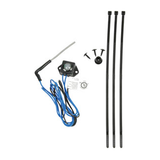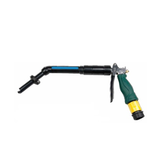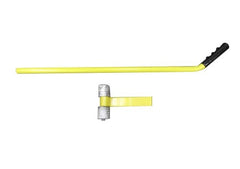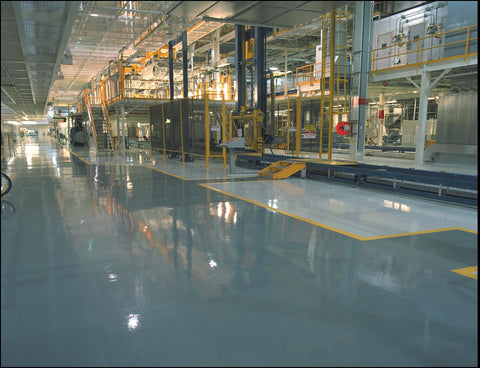|
|
|
|
|
|
|
|
|

|
|
|
If you are looking to effectively cut battery maintenance costs, you should learn more about battery watering kits. Battery watering kits provide a safe, reliable, and time-saving process for filling batteries.
BATTERY ACID
Battery acid, or sulfuric acid, is the main component of a lead-acid battery. Sulfuric acid is an electrolyte or liquid found in lead-acid battery cells. In addition to the sulfuric acid solution, batteries also contain water.
WHY DO WE NEED TO WATER A BATTERY?
A standard industrial, lead-acid battery consists of water to fulfill the sulfuric acid solution. After a battery is charged, it is important to check the water level to ensure that it is at a functional level for the lead-acid battery to continue its normal daily operations. A lead-acid battery’s functionalities are limited or defective when water levels dip too low or are absent altogether. Lead is a metal, any metal that is not maintained in the proper condition will rust, in this case damage the battery. That is why it is important that the water level in the battery is continually maintained.
The power from a lead-acid battery is created by the chemical reaction between the water and acid contained inside the battery. When a lead-acid battery is charged, the water inside the battery is consumed during the chemical reaction through which energy is created. Water also evaporates over time. When the water inside the battery is gone, the battery is dead. A battery watering kit prevents this type of deterioration and failure.
BATTERY WATERING KITS
Battery watering kits come with a single-point watering system that is either fully assembled or that must be assembled after purchase. The kit comes with neatly labeled diagram with instructions for an easy install. The kit consists of a series of tubes with multiple valves connected to them; the number of valves is equal to the number of cells in the battery. The battery watering kit is hassle-free and no tools are needed for assembly. Remove the battery cap, connect the kit, and then connect the water hose. Each cell is then filled up to the proper level. An indicator on the watering valves alerts you when water reaches the correct level. This indicator is designed for a wide visibility and can easily be seen from a distance. When each battery cell is appropriately filled, the water will automatically shut down. Repeat this process whenever the water level in the battery is low.
BATTERY WATERING KIT ACCESSORIES
Following the charging period of a battery, it is important to check the water level in an industrial lead-acid battery. Traditionally, this is done by taking the cap off each cell and making sure the water level is right within the levels of the battery plates (located inside the battery, are visible when you look inside the battery through the vent cap holes). While this is a tedious and time-consuming process, it is necessary to maintain a battery’s working condition. This is where a battery water monitor will save you all the time, money, and labor.
 Battery Water Monitors - - - A Battery water monitor is designed to be your eyes and ears inside the battery. The monitor is equipped with a bright LED visual indicator that alerts operators when it is time to water the battery. The battery water monitor will improve a battery life and eliminate over- and under-watering of batteries. Just like the battery watering kit, the battery water monitor is easy to install can be placed on any battery cell for an accurate read.
Battery Water Monitors - - - A Battery water monitor is designed to be your eyes and ears inside the battery. The monitor is equipped with a bright LED visual indicator that alerts operators when it is time to water the battery. The battery water monitor will improve a battery life and eliminate over- and under-watering of batteries. Just like the battery watering kit, the battery water monitor is easy to install can be placed on any battery cell for an accurate read. Watering Gun - - - The watering gun is helpful for manually filling each cell by hand. It is a safe and efficient method of watering batteries without an automatic watering system. A manual watering gun can be connected to a standard hose or deionizer. Place the tip of the gun into each individual battery cell and squeeze the trigger to continue the process.
Watering Gun - - - The watering gun is helpful for manually filling each cell by hand. It is a safe and efficient method of watering batteries without an automatic watering system. A manual watering gun can be connected to a standard hose or deionizer. Place the tip of the gun into each individual battery cell and squeeze the trigger to continue the process. Gravity Tank - - - A gravity tank is a simple device for filling single-point watering systems. The gravity tank is ideal to assist in applications in which the water will be plumbed into the tank. There is no need to fill the tank manually and the gravity tank can water multiple batteries at one time. Gravity tanks should be positioned a minimum of three feet above the batteries and should be properly secured to ensure proper and efficient water delivery to the battery cells.
Gravity Tank - - - A gravity tank is a simple device for filling single-point watering systems. The gravity tank is ideal to assist in applications in which the water will be plumbed into the tank. There is no need to fill the tank manually and the gravity tank can water multiple batteries at one time. Gravity tanks should be positioned a minimum of three feet above the batteries and should be properly secured to ensure proper and efficient water delivery to the battery cells. Direct Fill Link - - - Direct fill links can be used with a hose (connected to a janitor’s sinks, or spigot somewhere in the warehouse) or a portable water tank. The direct fill link operates like a watering gun equipped with a flow indicator wheel. Also, it is equipped with a pressure-sensitive handle and a connector like a garden hose connection. The direct fill tank does not include a handle lock, which makes it safer to operate because it will immediately shut off if left in a battery, eliminating the possibility of overfilling. The flow indicator encased in the PVC makes it both durable and lightweight. The DF72 model is fast enough to fill a large battery but gentle enough to fill small delicate battery without the risk of overflow.
Direct Fill Link - - - Direct fill links can be used with a hose (connected to a janitor’s sinks, or spigot somewhere in the warehouse) or a portable water tank. The direct fill link operates like a watering gun equipped with a flow indicator wheel. Also, it is equipped with a pressure-sensitive handle and a connector like a garden hose connection. The direct fill tank does not include a handle lock, which makes it safer to operate because it will immediately shut off if left in a battery, eliminating the possibility of overfilling. The flow indicator encased in the PVC makes it both durable and lightweight. The DF72 model is fast enough to fill a large battery but gentle enough to fill small delicate battery without the risk of overflow.
STEP-BY-STEP PROCESS OF INSTALLING A WATERING KIT
Installing A Fully Assembled Watering Kit: https://www.youtube.com/watch?v=4TDJ-tLaKd4
(If you have a battery water monitor, follow this same process once the monitor indicates that the battery needs watering and you have completed charging the battery.)
For more information on Battery Watering Systems and related items, please visit https://materialshandlingstore.com/
If you need help or advice on the products in our online store or have a question, we would be delighted to serve you. We will respond as fast as possible—within one business day during business hours in the Pacific time zone in the western U.S.
Please contact our warehouse experts at: 844-445-1119
Warehouse safety is preserved and continuously improved through the cooperation of the operators and pedestrians. Both operators and pedestrians have a responsibility to maintain and ensure safety. The first steps to safety on the move in any warehouse is to understand and know the rules. There needs to be constant communication of your intentions as a pedestrian and an operator in a warehouse; working together to sustain and keep everyone safe. Here are some essential safety measures for pedestrians and operators on the move.

by Dani LaMarche
 1. Camberjack: A camberjack is used to lift an orderpicker so that the load wheels can be changed. Instead of spending 10 minutes using a regular jack to get the base legs off the ground, you simply slip the wheels of the camberjack under the base leg, push the handle down, and you’re ready to change one side.
1. Camberjack: A camberjack is used to lift an orderpicker so that the load wheels can be changed. Instead of spending 10 minutes using a regular jack to get the base legs off the ground, you simply slip the wheels of the camberjack under the base leg, push the handle down, and you’re ready to change one side.
 2. Crimping Tool: A crimping tool is used to crimp ends onto cables when making cable assemblies. This tool will speed up making cable assemblies by eliminating a trip to get a cable assembly made. This tool has different sizing options to crimp just about any cable end. Simply place your end on the cable and use this tool to securely crimp it in place. Then your cable assembly is ready to be installed.
2. Crimping Tool: A crimping tool is used to crimp ends onto cables when making cable assemblies. This tool will speed up making cable assemblies by eliminating a trip to get a cable assembly made. This tool has different sizing options to crimp just about any cable end. Simply place your end on the cable and use this tool to securely crimp it in place. Then your cable assembly is ready to be installed.
 3. Chain Gauge: A chain gauge is used to measure chains on your forklift. It helps a mechanic determine if the chain needs to be replaced or if it is still in good shape. Simply use the chain gauge’s guide to determine if the links match up; if not, the chain needs to be replaced or tightened up. If the guide and the chain links match, then the chain is still in good working shape.
3. Chain Gauge: A chain gauge is used to measure chains on your forklift. It helps a mechanic determine if the chain needs to be replaced or if it is still in good shape. Simply use the chain gauge’s guide to determine if the links match up; if not, the chain needs to be replaced or tightened up. If the guide and the chain links match, then the chain is still in good working shape.
 4. Pistol Grip Grease Gun: A grease gun makes quick work of greasing forklift masts, load wheels and so on. The gun operates at 6,000 PSI and includes an 18-inch nozzle extension. Just slip the opened tube of grease inside the blue holder and you’re ready to go.
4. Pistol Grip Grease Gun: A grease gun makes quick work of greasing forklift masts, load wheels and so on. The gun operates at 6,000 PSI and includes an 18-inch nozzle extension. Just slip the opened tube of grease inside the blue holder and you’re ready to go.
 5. Altimeter: A digital multimeter measures AC/DC voltage, AC/DC current, resistance, capacitance, frequency, and duty cycle. This tool will help diagnose electrical problems, and prevent electrical problems while working on a forklift. To use, simply turn the dial to the desired measurement, plug in the leads, and power on the altimeter.
5. Altimeter: A digital multimeter measures AC/DC voltage, AC/DC current, resistance, capacitance, frequency, and duty cycle. This tool will help diagnose electrical problems, and prevent electrical problems while working on a forklift. To use, simply turn the dial to the desired measurement, plug in the leads, and power on the altimeter.
 Those who have experience working around industrial concrete flooring can tell you that it’s not as easy to maintain as one might assume. There’s a reason that the floor coatings business exists, and is so successful. Here are a few reasons it might be time to consider adding a floor coating to your facility.
Those who have experience working around industrial concrete flooring can tell you that it’s not as easy to maintain as one might assume. There’s a reason that the floor coatings business exists, and is so successful. Here are a few reasons it might be time to consider adding a floor coating to your facility.
One of the most obvious advantages of having a coated floor is that the end result looks much more attractive to both staff and visitors than its bare concrete counterpart. With options including multiple colors and styles, you can be as creative as you want with your warehouse flooring design. Applying a lighter color can even increase visibility and light reflectivity up to 100 percent, and save energy consumption in the long run.
Another one of the benefits of floor coating in your warehouse is cleaning. If you have ever tried to clean a bare floor with an automatic scrubber, you know that it can be a daunting task. Dirt magically seems to multiply and then sticks to everything including cracks in the floor and open control joints. Over time, that settled dirt slowly erodes the concrete causing a fine airborne dust that has the potential to result in respiratory problems for employees as well as damaging product and causing more work for those that have to eventually clean it off during distribution. Once a floor coating has been applied, it adds an easily cleaned, protective layer to prevent dirt from wearing down your floor. A floor coating also keeps the concrete from disintegrating and causing a dusty, unpleasant environment.
Urethane mortar and epoxy slurries have wear and compressive strengths that are five times greater than standard density concrete. This means you can rest assured that your floor will be able to withstand much more use and weight without damage, which minimizes your maintenance and repair costs. A professionally coated floor will also ensure that your floors are even and safe. Coated floors ideally reduce hazards that stem from employees tripping, or damaging equipment while driving over rough or uneven flooring.
No matter what environment you work in, there is a floor coating solution to keep your employees and your products safe while in your facility. Some of the available options include:
If you are interested in learning more about the floor coatings available, or getting a quote for your facility, please contact The Materials Handling Store at 1-844-445-1119 email us at store@raymondhandling.com for more information.
 Regardless of your budget, these five ways to extend your forklift battery life will save money and increase the longevity of your battery.
Regardless of your budget, these five ways to extend your forklift battery life will save money and increase the longevity of your battery.
All batteries have a limited life span, however, these simple steps can extend the life of your battery by months or even years.
Have additional questions, take a look at some of our other forklift battery resources:
There is absolutely no doubt that any vehicle that is well maintained will have a much longer lifespan. However, did you know that an average forklift that is kept in good operating condition with regular maintenance can last twice as long as an unmaintained forklift? We highly recommend these three critical forklift maintenance tips.

According to one source, almost 40 percent of mechanical services for powered industrial trucks (PITs) are done in-house across the United States alone. When servicing your forklift or heavy equipment, there are a few critical precautions that are absolutely necessary to do right. Following these guidelines will both ensure that it runs more efficiently and safely, saving your business both time and money.
All three of these tips are equally crucial to the performance of your equipment. Please give them equal consideration before attempting to make any major repairs on your own, or switching your equipment to in-house service. Always consult your owner/operator manuals for each piece of equipment. Raymond Handling Concepts Corporation offers technical and operator training courses, parts sales, rentals, and service throughout the Washington, Oregon, Nevada, Northern California, Alaska, Western Montana and Idaho areas. Contact us today if you would like more information.